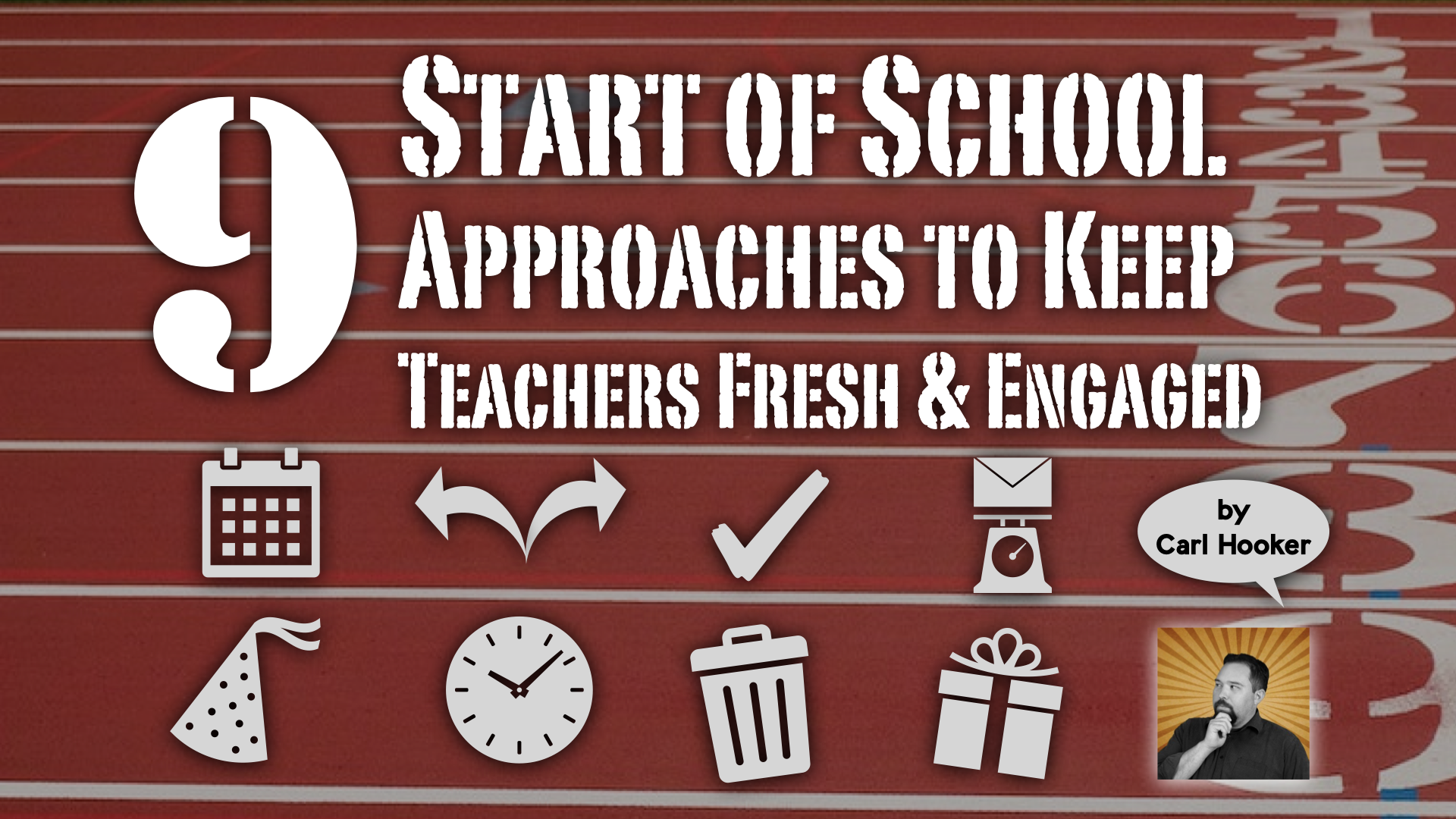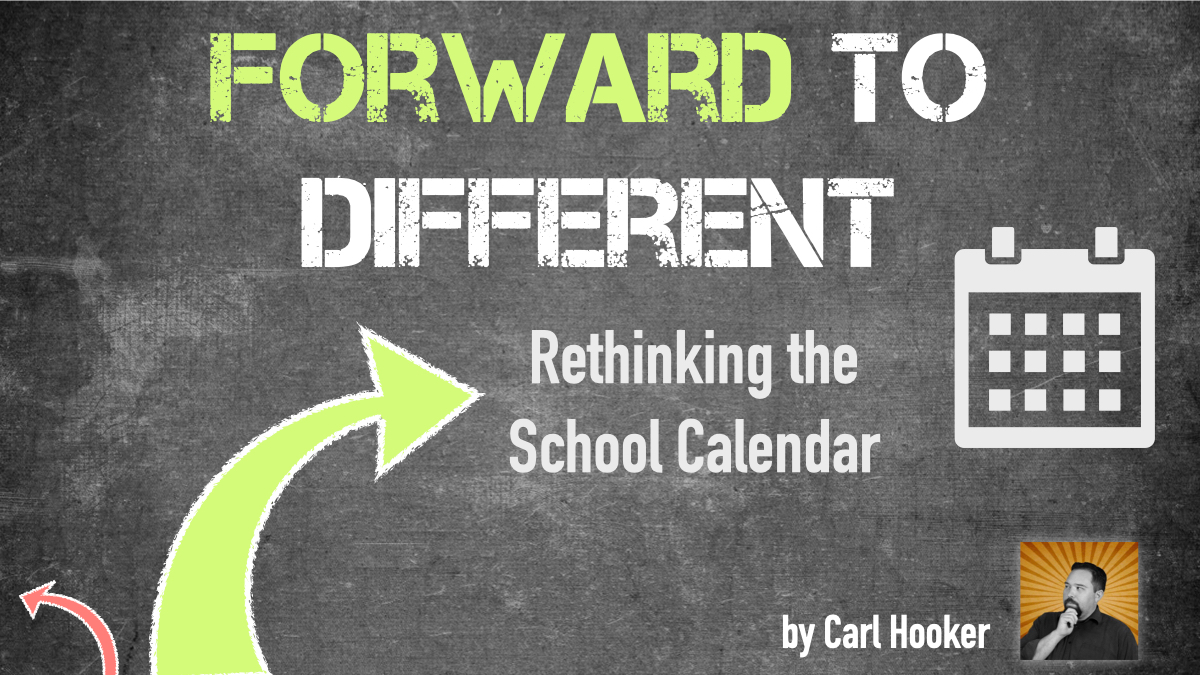9 Start of School Approaches to Keep Teachers Fresh and Engaged

As I enter my 24th year in education, I have been reflecting on all the different starts to the school year I’ve had. You know, those few days before the kids get back where we try to cram in all the latest state mandates or blood-born pathogen talks? As a teacher, I always felt a mixture of overwhelmed and excited to get my students in the classroom. As an administrator, I also felt overwhelmed and excited to prepare professional learning that gets my staff pumped to start the school year.
It’s a tough balancing act. Teachers want to be in their classrooms. Administrators have fires to put out. But somehow we must cram it into the 3-8 days before students enter our buildings. In my current role, I get to travel all over the country to be a part of “Start of School” activities. I’ve seen a lot of good and some bad when it comes to what staff are asked to accomplish. The approaches I outline below are my take on what I have found educators respond to best.
1. Allot time for classroom prep at the beginning
I’m going to start the list with what I think is the easiest to accomplish. Schedule a day or two at the beginning where teachers have some time in their classroom before the required meetings/trainings take place. One year, due to a new state evaluation plan, we had all staff attend two days of training before they had time in their classroom. Needless to say, that didn’t go well.
Most staff came back before their contract to work on their rooms, cutting their summer (and much needed recharge time) short. As the training happened in the largest building (the high school), most staff didn’t have a chance to pop into their classroom for any last minute adjustments. On top of that, most schools have a “meet the teacher” type event a couple of days before the students arrive, adding pressure on teachers to make their classrooms ready early. By flipping the schedule and granting teachers a couple of contract days dedicated to their classroom, you’ll find they are much more relaxed and engaged in whatever training you have to offer.
2. Make it a celebration
Sometimes it’s hard to celebrate during a “required training event” or a back to school planning meeting. This doesn’t have to be the case. Little touches like bringing in breakfast/lunch and having music playing can give staff a little more energy as they walk into the building. Some schools add themes and costumes to increase the fun and engagement of staff gathering together.
At my former district, Eanes ISD, we gathered all the staff together for a fun-filled convocation event that involved music, student performances, and “roll-call” from each school. The first few years, roll call involved staff cheering loudly when their school was mentioned. However, over the years, it turned into a competition as schools coordinated costumes, dance moves, and battle cries to show pride in their campus. These kick-off events are an opportunity to set the tone for the year and really build a sense of cohesive culture with all the staff.
3. Give staff choices
This should be the case with any professional learning, but especially at the beginning of the year. Staff dread reading an itinerary of all the places they have to be before the school year gets started. This month, I visited two different districts in Texas and Indiana who gave their staff choices about which sessions they wanted to attend. I even gave them the power to decide how my keynote would end.
Taking this concept of choice a step further, some of the offerings could be online and done in their own time. This way if they need some time to work on last minute classroom items, they can do that and still participate in the learning later. We moved most of our required trainings to an online video quizzing platform rather than forcing staff to sit through 6 hours of “legalese”. We also gave them through the month of September to complete these rather than try and finish them all before kids enter their doorway.
4. The gift of time
When I deliver keynotes, one of the activities I do is a “Would you rather” type game. Staff either stand or sit to identify which of the two items on the screen they most associate with. It’s a fun game and meant to get them moving, but one particular prompt always leaves me floored.
When I ask them if they would rather have more time or more money, the majority of educators choose time. I’ve said it before, but we are facing a “time famine” in education. You can make more money, but you can’t make more time. As leaders organize start of school activities, be thoughtful of a teacher’s time. Do they have time to prep their classroom? Do they have time to stop and reflect? Do they have time to take an “adult lunch” to bond with their colleagues?
After the school year starts, try to be aware that the students aren’t the only ones struggling with the start of school. I’ve always been a fan of starting school mid-week if possible. Have 2-3 days to get everyone back in the routine before going to the first full 5-day week. Or just move to a 4-day week all year like this Texas district.
5. Check in with staff
Administrators should try and be present for staff. That sounds like a small ask, but there are seemingly endless meetings and emails that need to get done. That said, take a break from that and walk your campus. Pop into classrooms and check on your teachers. Do they need some last minute copies? Maybe their favorite piece of chocolate or a coffee?
Stopping by to say hi, check stress levels, and being actively supportive will reduce staff anxiety. Once the year gets going and students enter the fray, be sure to walk the halls regularly. Whenever possible, administrators should try and step into the classroom to give teachers some small breaks, especially at the beginning of the year. It’s amazing what 5-10 minutes of “adult quiet time” can do to alleviate teacher stress.
6. Strategic abandonment of past initiatives
Every year, school leaders pick a word or theme to focus on during the school year. “Creativity” or “Risk-taking” can be great themes when supported with the right message and materials. However, just adding a new initiative every year to be different can be overwhelming. Some years, staff have to learn a new grade book system, a new curriculum adoption and adhere to a new state mandate. Throwing another thing on their plate fails to recognize teacher capacity and stress levels.
This is especially apparent at the beginning of the school year. Rather than give teachers “one more thing” to learn or focus on, take a few things off their plate. Maybe delay on implementing that new learning management system right away. Instead of introducing a new theme, have one carry over from the previous year. Addition by subtraction is a real thing when it comes to staff mental health.
7. Try an “inbox diet”
There are many important messages that need to go out at the beginning of the year. Staffing changes, enrollment updates, last minute meetings, and more can pile up a teacher’s inbox. Not to mention the parent emails looking for clarifications or information that they couldn’t find on a website.
Having an ever-growing inbox number of unread emails can subtly increase anxiety and stress. This is not the time to spam them with a cute TikTok hacks or a list of funny memes to share with their students. It will get lost in the shuffle. Instead, try and keep email communication to a minimum. Coordinate information from counselors, nurses, executive assistants, HR, and others so that teachers aren’t bombarded with 20+ messages filled with “administrivia”.
Also, encourage staff to turn off their email when they go home. Let the community know that teachers won’t be checking email from 6pm to 7am so they don’t expect an immediate follow-up. While there are always exceptions to this rule (like an emergency), allowing time to disconnect from school and recharge at home lays the foundation for a less stressful start to the year.
8. Little surprises go a long way
I’m not talking about the “Surprise! We have an emergency faculty meeting!” on this one. As a leader, I would yearly send out a pre-survey to my team to see their likes and dislikes. This could be a list favorite sodas, snacks, songs, etc. I would then use this data to bring them little “treats” that I know they like throughout the year.
It’s a small thing, but it can have a great impact on morale and motivation by adding a little personal touch to the gifts you give.
9. Have consistent messaging that motivates
One of the highest honors I have is being invited to be the opening speaker for a school year (see video here). It is so important to have staff excited and pumped to try new things and leave with a sense of purpose. However, the wrong opening speaker can send the wrong message to staff.
One year, we had a well-known speaker come in to tell our staff that our grading practices were wrong and needed to change. Hearing this message 2 days before the start of school was poor timing (especially without follow-through). Another time, we did a mock “active shooter” drill which left some staff in tears and others ready to quit right on the spot. While these messages may be necessary, timing is important.
If you bring me in to talk to your staff about taking risks and embracing failure, I would expect that you would celebrate this throughout the year. Have a plan to align with your opening message with leadership. With follow-through and support, an opening message can be the beginning of a positive snowball effect. Teachers leave feeling motivated and leadership supports that throughout the year to keep the momentum going.
Some of the items in this list are easy to do and many schools have already implemented them as best practices. It’s important for all staff to maintain good self-care as they enter into the daily roller coaster that is working with pre-adult humans. Starting the school year off on the right foot means staff are less likely to experience the dreaded late fall/early spring burn-out. Offering continual support by reducing initiatives, giving the gift of time and being present is an impactful way for a leader to keep their staff happy and energized.
Happy back to school y’all!
Recommend0 recommendationsPublished in Leadership Voices






Responses